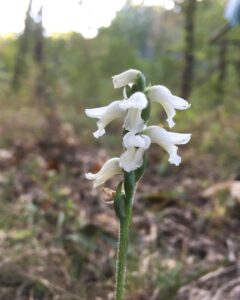Wild Haven Bush Honeysuckle Hack
by Roxie Campbell
We enjoyed a beautiful day and hike of about 1.3 miles one-way to reach the south end of the yellow trail that dead ends at a rocky section of Hinkson Creek. Our target was on the other side of the creek – a patch of bush honeysuckle (BH) I had spotted three years ago when ending work on BH on the west side of Hinkson Creek. I thought I’d come back to get these on another day, but alas, time went on. This is why we needed additional volunteers! On Oct. 4, it was great to have four CAS members and two journalist students receive training on identification and treatment methods. The “patch” had grown rapidly from a few three years ago, to 250. That’s how many we estimated that we treated. David found the “mama” bush which looked like a small tree with stems 5 inches in diameter! He returned with a chainsaw and cut it. Treatment methods used were “cut/stump” (cutting and spraying herbicide on the stumps), pulling small ones and “root docking” (using a tool to cut roots and pull). It only took us about 45 min. of work time to control this patch.
The ability of BH to increase in abundance so rapidly is why it ranks very high in the level of threat it poses to natural ecosystems. Another reason is that because it leafs out in early spring, persisting to late fall and becomes dense in the understory of a woodland. It shades the forest floor for the duration of the growing season and steals much needed sunlight from various native plants such as saplings of oak and hickory trees and spring wildflowers. While BH is a serious threat, it is a manageable one especially since the amount that has arrived is low. We are also treating a scattered few near Hinkson on the north end, but the vast majority of Wild Haven is free of BH! During our hike which spanned almost the entire length of Wild Haven and took both white and yellow trails, we saw only about six small BH and we treated them. So, if we are diligent to watch for and treat BH shortly after they arrive, we will be successful at protecting Wild Haven. We enjoyed seeing a great diversity of native flora including these of special note: 3 Ladies Tresses Orchids, Indian Plantain, Indian Pipe (white flowering plant that lives on dead wood and does not do photosynthesis), and several swamp white oaks. We also saw a three-toed box turtle.
There will be another training/work session on Sunday, November 15 from 2 to 4 pm. We’ll meet at the workshop and work in the area between the workshop and bridge. Email trjcamp at aol.com to get word if we reschedule due to weather. Dress for the weather, bring your own tools or borrow some.

